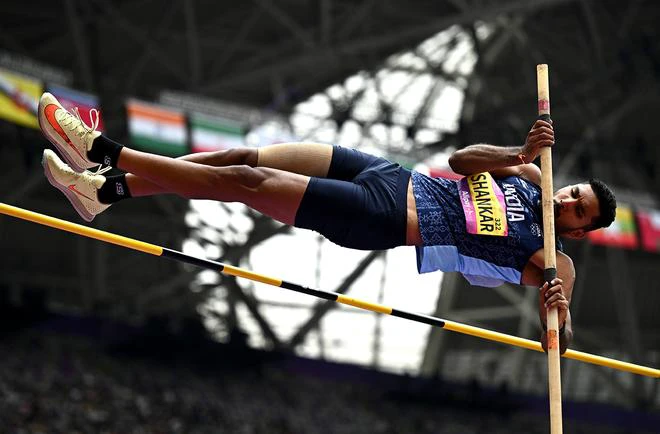A lift used by the Prime Minister, five-hour waits, and letters to multiple officials – this is how Tejaswin Shankar hauls his 16-foot poles to the Championships.
Tejaswin Shankar has set lofty goals for himself at this month’s Asian Athletics Championships in Gumi, Korea. He hopes not only to improve on the bronze medal he won in the previous edition in Bangkok, but also to better his decathlon national record of 7666 points.
However, while his competition begins on May 30, the real challenge for Tejaswin will start much earlier – on the day of his departure to Korea. That’s when he’ll have to figure out how to get his five, four-and-a-half-metre-long fibreglass poles onto the flight.
As a decathlete, Tejaswin usually travels heavy. He brings relatively few clothes, but a lot of specialised kit: different shoes for each event, massage gear, supplements, javelins, a discus, and sometimes his shot put. However, the toughest item to get through the New Delhi International Airport is the pole vault equipment.
When he can, the 25-year-old prefers to transport his poles by train, tucking them alongside the overhead fans in the sleeper compartment. That, though, is not an option when he flies.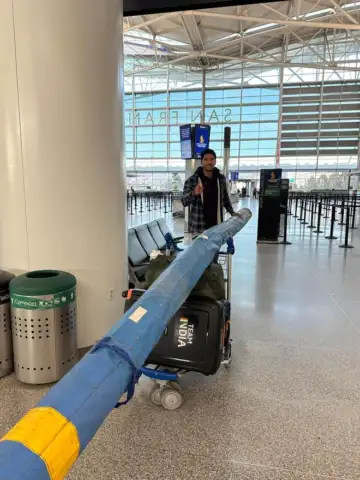
Logistical grind: From airline hassles to Customs delays, Tejaswin’s toughest vault often comes before the runway – just getting his poles there. | Photo Credit: SPECIAL ARRANGEMENT
“The first challenge is to get it past the CISF guards at the entry gates. The moment they see them, they say I can’t go inside. I’ll have to explain I’m an athlete and I’ve travelled with these things before. While they are making up their minds, there will be a bunch of passengers all staring at me thinking I’m carrying a weapon or something,” says Tejaswin.
Once inside, he still has to get the poles through the baggage counter. “Usually your javelins and those sorts of things can be accommodated in that big belt, but the pole vault poles cannot,” he says.
All baggage at Delhi’s Terminal 3 is transferred through two cargo lifts – neither of which can fit a 16-foot-long pole. A special lift has to be used instead.
Tejaswin discovered this the hard way when he first brought his poles from the USA, where he competed for Kansas State University in the NCAA. “The first time I came with my poles, I had a layover in Finland, and when I reached Delhi, I found that my poles hadn’t come on the plane. When they did get to India on a subsequent flight, I was told that even though they had taken the poles out of the plane, they didn’t know how to get it through the airport and that they were just going to send it back to Finland. That’s when I had to ring up everyone I knew in Indian sport. Finally, after nearly four days, one person told me that there is a third way of getting oversized baggage out of a plane – and that was through a location known as the ‘steel gate’.”
Accessing the gate is complicated for a reason. “I found out later that apart from me, the only time that steel gate is used is when the airlines are transporting catering, or when the Prime Minister is travelling. So my poles are a bit special!”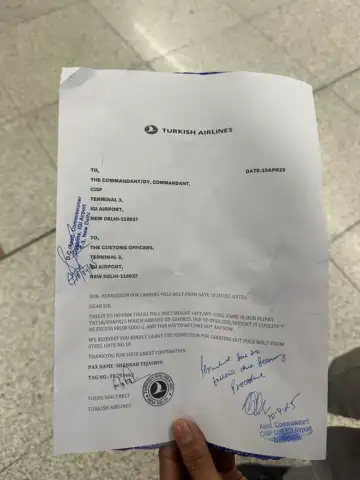
Letter from Turkish Airlines regarding transit of Tejaswin’s pole vaults. | Photo Credit: SPECIAL ARRANGEMENT
That same gate is used when Tejaswin flies out of the country with his poles. “First, I have to get a letter written by the airline to allow me to use that gate. At check-in, the first thing they say is it can’t be done because it’s such a huge hassle, so I always carry a copy of every letter I’ve had made out in the past. In the letter, the airline writes that they’ve accepted my baggage and that it can’t go through the two regular cargo lifts. The first time I got the letter made, they called it a ‘pole bolt’, and now every time I get a letter made, it says ‘pole bolt’.”
That letter is addressed to the CISF commandant, the head of security, and the head of customs, requesting permission to use the special gate. “I have to go and get the letter signed by all of them. This also takes time because it’s hard to catch all of them. Someone is on his rounds, someone else might be having tea.”
Eventually, the doors to that special cargo lift – about 15 feet high and 20 feet long, by Tejaswin’s reckoning – open, and the poles go in. The entire process, both outgoing and incoming, takes four to five hours. That’s something he must factor into every trip.
“Regardless of how many times I go through this procedure, it never gets easier. There’s a lot of running around, but more than that, you’re dependent on other people being available. I have to get there well in advance so the airline doesn’t have an excuse that I’m holding up boarding for other passengers or that there’s no space for my poles. If you’re one of the first people to go in, you can argue that the hold is empty.
“If you come in at your normal luxury time, there’s no way they are going to take the poles. If you come in early, they’re also fresh. Otherwise, their frustration levels go up. They also want to make sure the flight isn’t delayed. If you’re the first person to go, then at least they can find some way.”
No matter how early he arrives, Tejaswin says he’s usually one of the last passengers to board the plane. “It’s only then that I can finally relax.”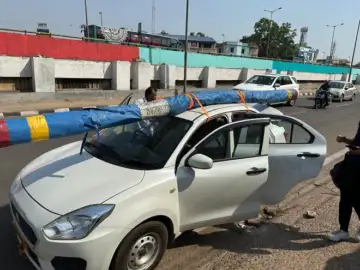
In all his years of competing, there’s been just one time when Tejaswin didn’t have to go through the stress. | Photo Credit: SPECIAL ARRANGEMENT
Things get easier once he lands – depending on the airport. “A lot depends on the airport you arrive at. Depending on where you are, the cargo lifts might be big enough to handle my poles. If that’s the case, it’ll just come out in normal baggage claim. It’s not a country problem – it’s an airport problem. While I have to do a lot of work in Delhi, I’ve been told that poles travel without a lot of issues in Bengaluru airport. I guess when Delhi airport T3 was being built, they didn’t think they needed to make a baggage lift that was big enough to carry Tejaswin Shankar’s 16-foot poles!”
So how do international athletes manage this? “What I’ve seen is that since elite pole vaulters usually compete either in Europe or the USA, they just keep one set of poles in each continent. So, they have a set in Europe, and when they travel there, they use those. And when they’re in the US, they use the set they’ve kept there.”
For the rest, it’s trial and error. Much of the knowledge is passed through informal channels. Tejaswin learned about the steel gate from a former pole vaulter turned coach. Now, he’s trying to systematise the information.
“I’ve reached out to a lot of international athletes and I’m making a list where pole vaulters can see which airports and airlines are helpful in carrying poles and which are not. Some carriers like American Airlines and British Airways clearly say they don’t allow poles. Others, like Thai Airways and Singapore Airlines, are much more helpful. There are also aircraft like the Airbus A320 that don’t allow poles in the cargo hold – so it’s best to avoid them. It’s a work in progress, but I’m trying to create a resource that other athletes can use.”
Most competitions offer standard poles for use, but athletes prefer their own. Poles vary in length and stiffness based on the athlete’s jumping ability – Tejaswin’s longest is 15.7 feet, while world record holder Mondo Duplantis uses poles nearly 18 feet long.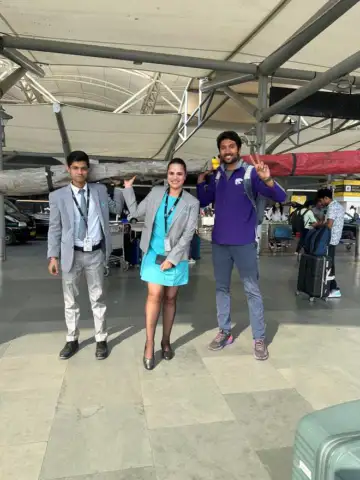
Since elite pole vaulters usually compete either in Europe or the USA, they just keep one set of poles in each continent. | Photo Credit: SPECIAL ARRANGEMENT
“It’s really important to travel with your own poles. It’s like an extension of your hand. Every pole feels different. It’s like playing with golf clubs or a cricket bat. Even if every pole looks the same – poles vary by length and stiffness – everything feels off when you use one that’s not yours.”
Even then, success is not guaranteed. “It’s still possible that even if you manage to bring your own poles, you fail to make a clearance in competition. When I think about that, sometimes the hassle of carrying a pole seems more than the benefit. I think it’s even more of a trade-off for me compared to a dedicated pole vaulter, since this is just one of nine events I do. So, the return is much less than the risk or hassle. But at the end of the day, I don’t think there’s any real option but to go through all of this.”
In all his years of competing, there’s been just one time when Tejaswin didn’t have to go through the stress.
“When I won silver at the Asian Games in Hangzhou, I got off the plane and a representative from Singapore Airlines told me my luggage had already arrived. I said that’s great, but I need my poles, and I knew that would take its own time. This time, though, my poles were already waiting for me. Someone even helped me carry them out of the airport. That showed me that I didn’t have to go through all that procedure. But I guess it was different then, because they saw I was coming back as an Asian Games medallist. I guess that’s some sort of motivation too – if I do well enough at a big enough competition, I’ll just have my poles waiting for me when I get off the plane.”
